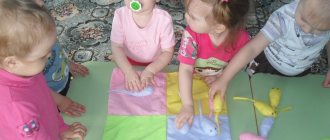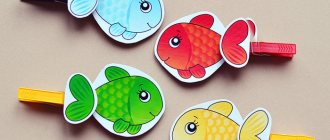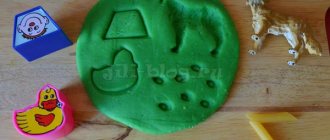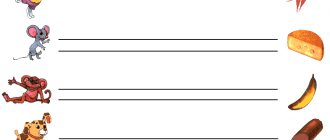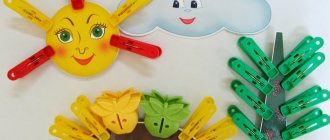A collection of games and exercises for developing fine motor skills
Natalya Shardakova
A collection of games and exercises for developing fine motor skills
We play, we play - we develop
Compiled by: Shardakova N.P., teacher.
“The origins of children’s abilities and gifts are at their fingertips. From them, figuratively speaking, come the finest streams that feed the source of creative thought. The more confidence and ingenuity in the movements of a child’s hand, the more subtle its interaction with the tool, the more complex the movements necessary for this interaction, the brighter the creative element of the child’s mind. The more skill in a child’s hand, the smarter the child.”
V. A. Sukhomlinsky
Games with fingers and hands stimulate the process of speech and mental development of children , develop fine motor skills of the fingers and coordination of movements. Such fun is very exciting. They promote the development of creative activity.
The collection includes exercises and games for the development of children's fine motor skills using various toys and games, factory-made or independently made from scrap and waste materials. Ordinary objects that can be used for play, involving the child in helping with housework.
The collection is recommended for teachers of children's homes, junior kindergartens and parents.
There are many toys on sale that are very useful for developing fine motor skills . Among them, for example:
• sorters” (cubes with holes of different shapes and inserts of different shapes)
– you can do it yourself by cutting holes in a cardboard box and inviting the child to put corks, lids from jars, etc. into the holes);
• lacing – you can do it yourself by taking cardboard and laces;
wooden frames - “puzzles”
and inserts for them with a handle
(usually in the form of apples, bananas, etc.)
;
• wax crayons ;
• kits for creating paintings, beads, etc. from small plastic tubes or beads;
•puzzles:
• mosaics;
• pyramids;
• matryoshka;
• designers;
• small animal toys , cubes, cars;
• box or “magic bag”
, where by touch you need to find an object by agreement or grope and describe the object.
You can make it yourself or buy it;
• finger paints, depending on the manufacturer - some can be used as early as a year.
A variety of subject-based activities have also proven themselves well, which also contributes to the development of fine motor skills .
Some ideas for developing fine motor skills :
• Finger drawing on a tray (mirror)
with cereal, jelly, shaving cream.
• Stringing clothespins on ropes, edges of plates.
• "Sprinkling"
- sand, sugar, semolina.
• Pouring water from one vessel to another; pouring loose objects (cereals)
from one vessel to another.
You can spray water into toys using a plastic (disposable)
syringe without a needle.
• Playing with water and a soft sponge.
• Pulling thread out of fabric.
• Applique (tear off pieces of thin paper or cotton wool and glue to the base;
• working with natural materials (cones, acorns, leaves, etc., small objects (buttons, rhinestones, shells)
– gluing using plasticine.
• Catching small toys from the bath using a spoon or ladle.
•Learning to unscrew lids: open a screw-on jar; open tubes of toothpaste and bottles;
• open a box of matches with some interesting small item or tasty treat inside;
• push the pencil, drop the beans into an empty plastic bottle;
• open and close markers, felt-tip pens.
• In everyday life, the child must learn to fasten and unfasten buttons and zippers
,
Velcro
, lace up shoes, roll up sleeves.
• An empty plastic soda bottle. You can fill it with beads and rattle it, or you can stick a pencil in it or lower the beads.
• Empty yogurt containers. You can cut them into rings and put them on the pegs.
• Cardboard tubes used for paper towels or toilet paper. Can be used as "pegs"
for putting on rings or as
“tunnels”
for cars.
• Empty bottles with a dispenser, like dishwashing detergent. Wash them well and use them for bath play.
• Wrist bracelets. Wearing a bracelet across the entire hand develops children's sense of touch.
• The child dips his hands into a vessel filled with some homogeneous filler (water, sand, various cereals, pellets, any small objects , and for 2-3 minutes he seems to mix the contents. Then he is offered a vessel with a different filler texture. After several tests, the child with closed eyes, he lowers his hand into the offered vessel and tries to guess its contents without feeling its individual elements with his fingers.
• Retrieving toys from the cereal pool will be a useful and fun activity. To make such a pool, you need to pour in cereals (peas, beans, wheat, pearl barley)
in the basin, put various toys
(preferably not very large)
and invite the baby to find the toys in this pool.
This play exercise not only promotes the development of fine motor skills , but also massages the baby’s hand and develops his tactile sensations.
• Take a bright tray. small grains onto a tray in a thin, even layer . Run your baby's finger over the rump. You will get a bright contrasting line. Let your child draw a few chaotic lines himself. Then try to draw some objects together (fence, rain, waves)
etc.
• Choose buttons of different colors and sizes. First, lay out the drawing yourself, then ask your child to do the same on his own. After the child learns to complete the task without your help, invite him to come up with his own versions of the drawings. You can use a button mosaic to make a tumbler, a butterfly, a snowman, balls, beads, etc.
• Give your child a round hair brush. The child rolls the brush between his palms, saying:
"At the pine, at the fir, at the Christmas tree
Very sharp needles.
But even stronger than the spruce forest,
The juniper will prick you.”
• Take a sink grate (usually it consists of many squares)
. The child walks with his index and middle fingers, like legs, along these cells, trying to take steps on each stressed syllable. You can “walk” alternately with one hand and then with the other, or you can do it with both at the same time, saying:
"We wandered around the zoo,
Each cell was approached
And they looked at everyone:
Bear cubs, wolf cubs, beaver cubs.”
• Take the dumpling maker. Its surface is similar to a honeycomb. Baby with two fingers (index and middle)
depicts a bee flying over a honeycomb:
“Fingers, like bees, fly through the honeycombs
And they enter each one with a check: what is there?
Will we all have enough honey until spring?
So that you don’t have hungry dreams?”
• Pour 1 kg of peas or beans into a pan. The child puts his hands in there and imitates kneading dough, saying:
“Knead, knead the dough,
There is room in the oven.
They will be out of the oven
Buns and rolls."
• Pour dry peas (beans)
. For each stressed syllable, the child transfers the peas, one at a time, to another mug. First with one hand, then with both hands at the same time. Any quatrains can be selected.
• Pour in peas (beans)
on a saucer.
The child takes a pea with his thumb and forefinger and holds it with the other fingers (as when picking berries , then takes the next pea, then another and another - so he picks up a whole handful. You can do this with one or two hands.
• Place two caps from plastic bottles on the table threaded up. These are “skis”. The index and middle fingers stand in them like feet. We move on the “skis”, taking one step for each stressed syllable:
“We are skiing, we are rushing down the mountain,
We love the fun of cold winter."
• We build a “log house” from matches or counting sticks. The higher and smoother the log house, the better.
• Clothespin (check on your fingers to make sure it's not too tight)
alternately “bite” the nail phalanges
(from the index to the little finger and back)
on the stressed syllables of the verse:
“The silly kitten bites hard,
He thinks it's not a finger, but a mouse. (Change hands.)
But I'm playing with you, baby,
And if you bite, I’ll tell you: “Shoo!”
• We stretch the rope at the level of the child’s shoulders and give him several clothespins. For each stressed syllable, the child attaches a clothespin to the rope:
“I’ll pin the clothespins deftly
I’m on my mother’s rope.”
• The child crumples a handkerchief (or plastic bag)
so that it all fits in your fist.
•The child rolls a walnut between his palms and says:
"I'm rolling my nut,
To become rounder than everyone else.”
• The child holds two walnuts in one hand and rotates them around one another.
• Modeling from salt dough.
Here is the recipe for salt dough:
1 cup flour, 3/4 cup salt, 5 tbsp. spoons of vegetable oil,
a little warm water, a little starch.
For color, you can add gouache, beet or carrot juice to the dough.
Dissolve salt in a minimum amount of water, knead everything together.
The dough can be used repeatedly and stored in the refrigerator in a closed jar.
To harden, place the figurine in a cold oven and bake over medium heat. Cooled figures can be painted and varnished.
• Exercises with dough:
Pinch off pieces with two fingers, then stick them on (for example, eyes)
.
Clap the dough, flatten it with your whole palm, roll sausages with your palm and each of your fingers.
Imprint fingers and chopsticks on the dough.
Combine dough with other materials (peas, beans, twigs, vermicelli, straws)
You can make rings and string them on a cord.
• Small screw-on bottles (game for children 2-3 years old)
Hide small toys or candy , and leave some of the bottles empty. Invite your child to guess in which bottles the toys are hidden. It will be very good if he himself thinks of shaking the bottle and listening to see if there is anything there. Once all items have been removed, ask your baby to close the bottles.
The game develops auditory attention and fine motor skills .
• Cream jars (game for children 2-3 years old)
Invite your child to unscrew all the caps, and then, after mixing them, close them again. You can play with three to five jars or more. Please note: all jars must be different, so that only a different lid fits each one.
The game develops visual perception, visual memory, fine motor skills .
• Clothespins (game for children 3-5 years old)
Attach clothespins to a cardboard circle to create a “sun”
or
"flower"
. You can design the toy in the shape of a hedgehog, with clothespins acting as needles. Invite your child to remove all the clothespins and then reattach them. If there are a lot of clothespins, they are of different colors and configurations, then the children themselves can come up with a lot of crafts.
The game develops fine motor skills and hand-eye coordination.
Here are exercises in which a baby can train fine motor skills , helping parents and feeling needed and almost an adult:
• Remove the skin from vegetables cooked in their skins. Peel hard-boiled eggs. Peel tangerines.
• Pick up debris from the floor. Help collect objects scattered on the floor (buttons, carnations, beans, beads)
.
• Help wind threads or rope into a ball (it’s better to keep silent about who unwound them)
.
• Polish shoes for the whole family with a special sponge.
• Help parents unscrew various caps - water cans, bubble baths, toothpaste, etc.
• Help sort out the cereal.
• Tear, crumple paper and stuff it into shoes being stored.
• Wipe away dust without missing anything.
• Turn lights on and off.
• Look for the edge of the tape. Peel and stick stickers.
• Turn the pages of a book.
• Sharpen pencils (with a sharpener)
. Erase the drawn scribbles with an eraser.
• Pour liquids from one container to another.
• Play with mosaics and puzzles.
• Sort buttons or other items by size.
• Collect construction sets.
• Place objects in narrow openings, such as the neck of a bottle.
• Model together from plasticine.
• Paint. Holding pencils and brushes in your hands is an excellent way to develop motor skills , no worse than special exercises . Teach your child to trace drawings and objects along the contour. Paint not only with brushes, but also with your fingers. Now there are special paints for this.
• Cut out different shapes from paper.
• Motor skills are also developed by other simple and familiar activities - braiding hair, combing dolls, putting toys in their places and much more.
• While walking, build castles, slides, and other figures from sand or pebbles. Coarse sand and stones develop palms .
• Invite your child to help you with the housework - making dumplings, kneading dough, weeding beds, sewing, picking berries - a great alternative to games.
• Buy soft toys filled with small balls . They are designed specifically for the development of children's fine motor skills .
• Always play with toys of different sizes, shapes and sizes.
Safety precautions
To ensure that games aimed at developing fine motor skills do not cause harm to the baby, parents should follow the following rules.
- After the lesson, carefully remove all small objects so that a curious child, having discovered a familiar “entertainment”, does not accidentally swallow it or stick it in his nose or ear.
- During the training, the baby must be supervised. It is important for an adult to control literally every movement, because the child does not yet understand that he can harm himself.
These simple rules will help you avoid accidents.
The development of fine motor skills with the help of didactic games and exercises should become a habit for both parents and children. It is necessary to train with your child every day, coming up with new stories and using a variety of available means.

